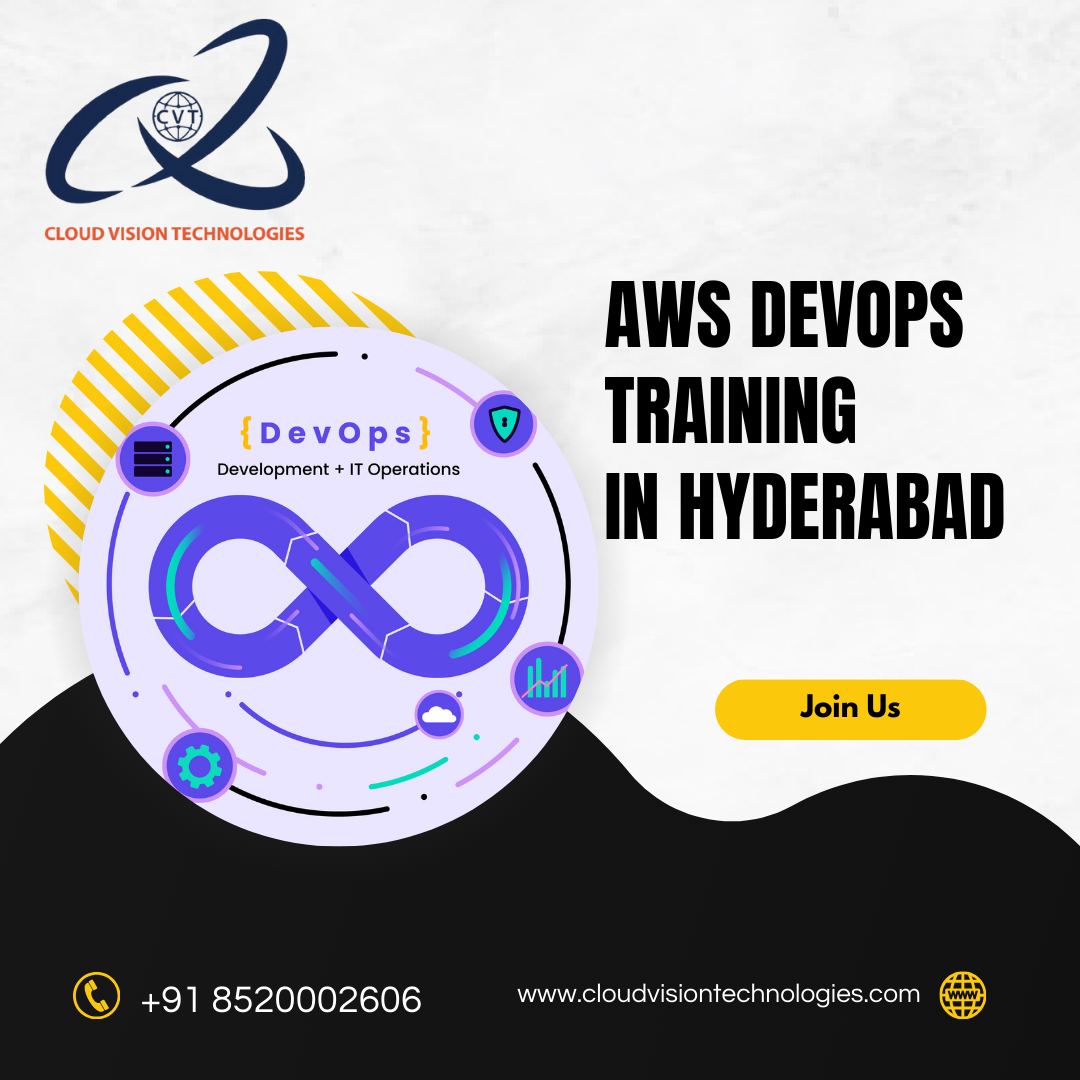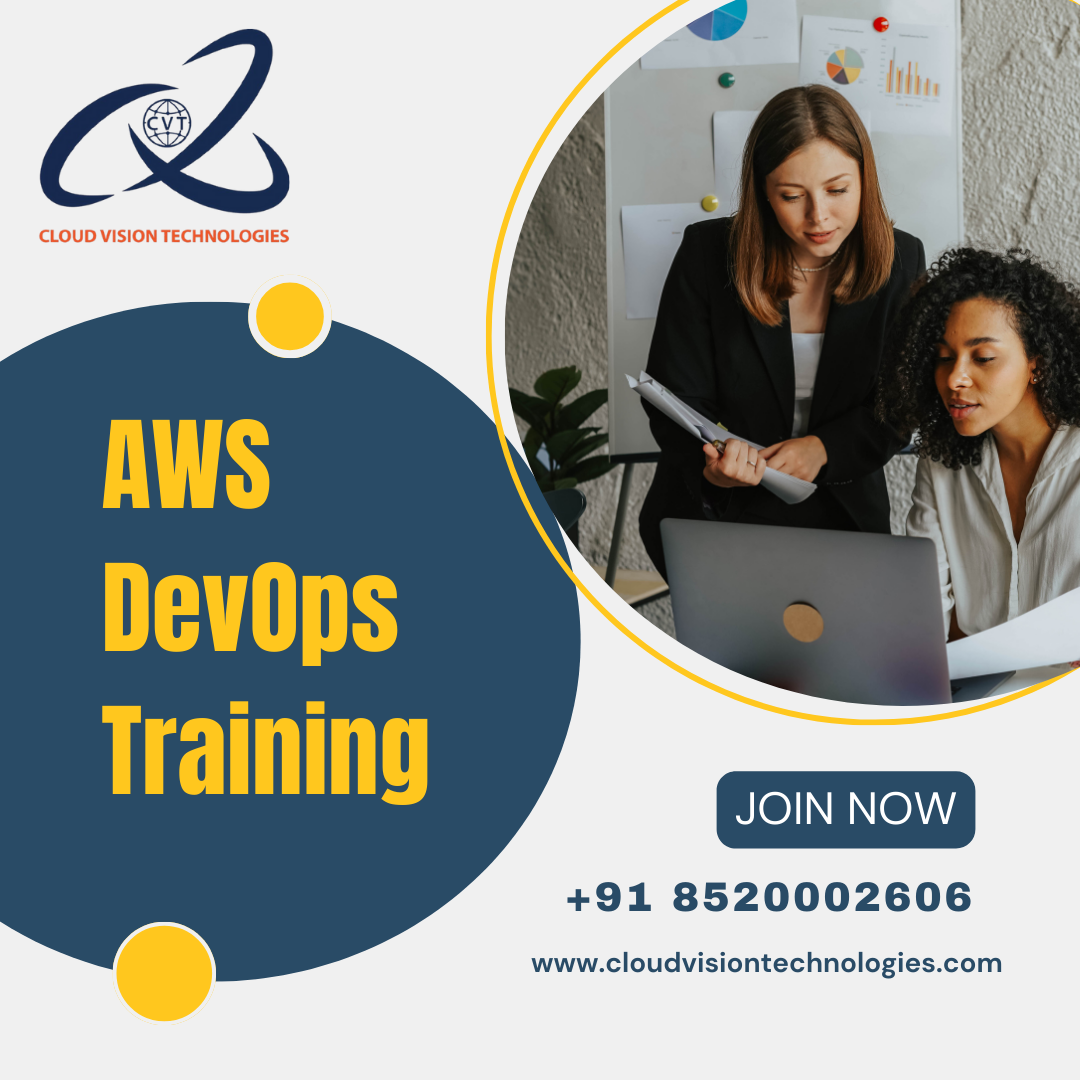
DevOps Course in Hyderabad
Introduction to DevOps:
DevOps Course in Hyderabad, It is a set of practices, tools, and cultural philosophies that aim to bridge the gap between software development (Dev) and IT operations (Ops). By promoting collaboration between these teams, DevOps helps organizations build, test, and release software faster and with fewer errors. Cloud Vision Technologies.
What is DevOps?
DevOps is a combination of Development (Dev) and Operations (Ops), it’s a cultural and technical movement that brings software development and IT operations teams together to work more collaboratively and efficiently. The goal of DevOps is to shorten the software development lifecycle and deliver high-quality software continuously and reliably.
Instead of working in separate silos, DevOps encourages developers, testers, system admins, and other stakeholders to collaborate throughout the entire lifecycle from planning, development, and testing to deployment, monitoring, and maintenance. DevOps Course in Hyderabad.

Why DevOps?
Before the rise of DevOps, software development and IT operations were traditionally treated as separate functions within an organization. The development team was responsible for writing code and building features, while the operations team handled infrastructure management, deployment, and system maintenance. While this division of labor seemed logical, it often created a significant communication gap between the two teams. DevOps Course in Hyderabad.
Once developers finished writing code, they would typically “throw it over the wall” to the operations team for deployment. The operations team, however, might not have been involved in the earlier stages of the development process and often lacked critical context about the application. This disconnect led to misunderstandings, configuration mismatches, and deployment issues, causing delays and instability in production environments.
As a result, software releases were frequently delayed. Developers would blame operations for slow deployments, while operations would blame developers for unstable or untested code. This cycle of finger-pointing made collaboration difficult and created a tense work environment. The lack of shared responsibility meant that teams often prioritized their own goals instead of focusing on the overall success of the software. DevOps Course in Hyderabad.
Furthermore, the siloed approach made it challenging to respond quickly to user feedback or market changes. Fixing bugs or adding new features required lengthy handoffs and manual processes, increasing the risk of human error. Downtime became more common, and customers had to deal with inconsistent experiences, reducing trust in the product.
Key Principles of DevOps
Collaboration
At the heart of DevOps is collaboration. Unlike the traditional approach where development, operations, and quality assurance (QA) teams worked in silos, DevOps encourages a culture of shared responsibility. By improving communication between these teams, DevOps ensures that everyone involved in the software development life cycle is aligned with the same goals. This collaboration leads to faster problem-solving, smoother workflows, and a more efficient path from idea to deployment. It also fosters a sense of ownership among all team members, as they work together toward delivering high-quality software. DevOps Course in Hyderabad.
Automation
One of the major driving forces behind DevOps is automation. By automating repetitive and error-prone tasks such as code integration, testing, deployments, and infrastructure provisioning, teams can focus more on innovation and less on manual work. Automation not only speeds up the development process but also ensures consistency and reduces the chances of human error. This leads to more reliable releases and allows organizations to deliver software at scale with greater confidence. DevOps Course in Hyderabad.
Continuous Integration (CI)
Continuous Integration (CI) is the practice of frequently merging code changes into a shared repository, where automated builds and tests are run. The goal is to detect issues early in the development cycle, making it easier to identify and fix bugs quickly. CI helps maintain code quality, reduces integration problems, and enables developers to work more efficiently as they receive immediate feedback on their code. This principle keeps the codebase stable and allows teams to confidently make changes and improvements.
Continuous Delivery (CD)
Building on the foundation of CI, Continuous Delivery (CD) ensures that every code change is automatically prepared for a release to production. CD makes it possible to deploy updates frequently, with minimal manual intervention, and ensures that new features, bug fixes, or security patches can be delivered quickly and reliably. This practice allows teams to respond to customer feedback faster, improve user satisfaction, and stay competitive in the market. It also reduces deployment risks by making releases smaller and more manageable.
Monitoring and Feedback
In a DevOps environment, monitoring and feedback are essential for continuous improvement. By using monitoring tools to track application performance, server health, and user behavior in real-time, teams can quickly detect anomalies or issues before they affect users. Feedback from monitoring helps developers understand how the software performs in production and provides insights into potential improvements. This loop of constant observation and adjustment creates a proactive approach to problem-solving and enables teams to build more resilient and efficient systems over time. DevOps Course in Hyderabad.

DevOps Lifecycle
The DevOps lifecycle is a continuous process that integrates development and operations teams to improve collaboration, efficiency, and delivery speed. It consists of several stages that work together to automate and streamline the software development process. Let’s break down each stage:
Plan
The life cycle begins with the planning phase, where the team defines the project’s scope, requirements, goals, and timelines. This is where product managers, developers, testers, and operations collaborate to identify customer needs, technical specifications, and business objectives. Using tools like Jira, Trello, or Azure Boards, teams create user stories and task lists to guide the development process. A well-structured plan lays the foundation for a successful project. DevOps Course in Hyderabad.
Develop
Once planning is complete, the next step is to develop the application. Developers write and review the code, working in small, manageable increments. Version control systems like Git help track changes, manage code branches, and enable collaboration among multiple developers. Code reviews and pair programming are often used to maintain quality and consistency. This phase is iterative, and frequent commits allow for better integration and testing later on. DevOps Course in Hyderabad.
Build
In the build stage, the written code is compiled, and executable files or build artifacts are created. This process often includes packaging the application along with its dependencies. Build automation tools like Maven, Gradle, or Jenkins automate this step, ensuring that builds are consistent and repeatable. The build process also includes tasks like static code analysis, code linting, and setting up containers using tools like Docker. DevOps Course in Hyderabad.
Test
After building the application, it’s time to test it thoroughly. Automated testing plays a crucial role in DevOps, allowing teams to catch bugs and issues early in the pipeline. Unit tests, integration tests, UI tests, and security scans are commonly executed using tools like Selenium, JUnit, or TestNG. Continuous testing ensures that only stable code proceeds to the next stage, significantly reducing the chances of failures in production.
Release
Once testing is successful, the application is ready for release. In this stage, the team packages the application and prepares it for deployment to production or staging environments. Release management tools help ensure smooth coordination, scheduling, and tracking of deployments. This phase also includes final approvals and documentation to ensure the product is ready for users. DevOps Course in Hyderabad.
Deploy
The deployment stage involves automatically rolling out the application to production environments. With the help of CI/CD pipelines, deployments can be done with minimal manual effort, reducing the risk of human error. Tools like Jenkins, GitLab CI/CD, or AWS CodeDeploy facilitate smooth, repeatable deployments. Some organizations also implement blue-green or canary deployments to minimize downtime and test changes on a small user segment first. DevOps Course in Hyderabad.
Operate
Once deployed, the software enters the operation phase. This involves managing infrastructure, ensuring system uptime, and handling configurations. Tools like Kubernetes, Docker Swarm, and Ansible help manage scalable environments, auto-scaling, and resource optimization. This phase also includes incident management and support to ensure the application is stable and available for users. DevOps Course in Hyderabad.
Monitor
Finally, the monitoring stage provides visibility into application performance, user behavior, and infrastructure health. Continuous monitoring tools like Prometheus, Grafana, ELK Stack, and New Relic collect metrics and logs in real-time. This feedback loop helps teams detect issues proactively, improve system reliability, and plan future updates based on real-world usage and performance data. DevOps Course in Hyderabad.
Popular DevOps Tools
Each phase of the DevOps lifecycle is empowered by a variety of tools that help teams collaborate better, automate processes, and improve software quality. Let’s explore the most widely used DevOps tools across different stages:
Version Control:
Version control is a critical component of any DevOps process. Tools like Git allow developers to track code changes, collaborate on codebases, and maintain multiple branches of development. Platforms like GitHub and GitLab extend Git by offering cloud-based repositories, issue tracking, and project management features. These tools promote team collaboration and ensure that all code changes are recorded and can be reverted if needed. Git-based workflows are the foundation of continuous integration and delivery. DevOps Course in Hyderabad.
CI/CD:
Continuous Integration and Continuous Delivery (CI/CD) are made possible by tools like Jenkins, GitLab CI/CD, and CircleCI. These platforms automate the process of building, testing, and deploying code, reducing the need for manual intervention. Jenkins, for instance, is a highly customizable open-source tool that supports a wide range of plugins to fit any development pipeline. These tools help teams integrate changes quickly and deliver updates to production efficiently, ensuring high code quality and fast feedback loops.
Containerization:
Containers are a lightweight way to package and run applications along with all their dependencies. Docker is the most popular containerization tool, enabling developers to create portable, consistent environments from development to production. Podman is a daemonless container engine that offers similar functionality with a greater focus on security. These tools eliminate the “it works on my machine” problem by ensuring consistent behavior across different environments. DevOps Course in Hyderabad.
Orchestration: Kubernetes
When applications scale to hundreds or thousands of containers, orchestration tools like Kubernetes become essential. Kubernetes automates the deployment, scaling, and management of containerized applications. It helps ensure high availability, load balancing, and fault tolerance. With Kubernetes, teams can manage complex application infrastructures with ease, making it an industry-standard tool in modern DevOps environments. DevOps Course in Hyderabad.
Configuration Management:
Managing and configuring servers manually can be time-consuming and error-prone. Tools like Ansible, Chef, and Puppet automate infrastructure provisioning and configuration management. These tools use code to define infrastructure (Infrastructure as Code or IaC), making deployments repeatable and consistent. Ansible is especially popular for its simplicity and agentless architecture, while Chef and Puppet are known for their robustness in managing large-scale systems. DevOps Course in Hyderabad.

Monitoring:
Monitoring is crucial for maintaining the health and performance of applications in production. Prometheus is a powerful monitoring and alerting toolkit designed for reliability and scalability. Grafana integrates with Prometheus and other data sources to create beautiful, interactive dashboards. Meanwhile, the ELK Stack (Elasticsearch, Logstash, and Kibana) is widely used for log aggregation, analysis, and visualization. These tools help DevOps teams detect issues in real-time, understand system behavior, and make data-driven decisions. DevOps Course in Hyderabad.
Cloud Platforms:
Cloud platforms provide the backbone for deploying and scaling applications. Amazon Web Services (AWS), Microsoft Azure, and Google Cloud Platform (GCP) offer a wide range of services including computing, storage, networking, and managed DevOps tools. They support container orchestration, CI/CD pipelines, monitoring, and security services, enabling teams to build and operate applications in the cloud with speed and flexibility.
Benefits of DevOps
Faster Time to Market
One of the most significant benefits of adopting DevOps is the ability to deliver software faster. With automated pipelines and continuous integration and delivery (CI/CD), code can move from development to production much more quickly. Teams can release new features, updates, and bug fixes in days or even hours instead of weeks or months. This accelerated pace allows businesses to respond rapidly to market demands, stay competitive, and reduce the lead time between ideation and customer delivery. DevOps Course in Hyderabad.
Improved Software Quality
DevOps emphasizes automated testing, code reviews, and continuous monitoring, which significantly improves software quality. Bugs and vulnerabilities are detected earlier in the development cycle, reducing the chances of them reaching the end users. As testing becomes a continuous process rather than a final step, the application is constantly evaluated for quality. This leads to more stable, reliable, and secure software that performs well under real-world conditions. DevOps Course in Hyderabad.
Fewer Bugs in Production
Thanks to continuous integration and automated testing, code defects are caught early, long before the code reaches the production environment. Frequent, smaller releases also mean that issues can be isolated and resolved more easily compared to dealing with large, infrequent deployments. This approach not only decreases the number of bugs in production but also ensures faster recovery when issues do occur. Ultimately, this leads to a smoother and more stable user experience. DevOps Course in Hyderabad.
Better Team Collaboration
DevOps breaks down the traditional silos between development, operations, and QA teams. By encouraging cross-functional collaboration, teams work together throughout the entire software lifecycle, from planning to monitoring. This shared responsibility fosters a culture of transparency, accountability, and mutual respect. Communication becomes more streamlined, problems are resolved faster, and the overall workflow becomes more efficient and enjoyable for everyone involved. DevOps Course in Hyderabad.
Greater Agility and Scalability
With DevOps, teams can respond quickly to changes, whether it’s market trends, customer feedback, or internal business needs. The use of cloud platforms, containerization, and orchestration tools like Kubernetes makes it easier to scale applications up or down based on demand. This agility allows businesses to experiment with new ideas, iterate quickly, and maintain high performance even under heavy traffic or growing user bases. DevOps Course in Hyderabad.
Enhanced Customer Satisfaction
All these benefits ultimately lead to one powerful outcome: happier customers. When software is delivered faster, works more reliably, and evolves based on user feedback, customers feel heard and valued. Continuous delivery ensures that improvements are rolled out regularly, while monitoring tools help proactively fix issues before they affect end users. This level of responsiveness and quality builds trust and loyalty among customers, which is key to long-term success. DevOps Course in Hyderabad.
DevOps course in Hyderabad
Are you looking to start a career in DevOps or upgrade your skills with the latest industry tools and practices? Our DevOps course in Hyderabad is designed to equip you with real-world knowledge, hands-on experience, and job-ready skills that top companies are looking for. Hyderabad is one of India’s leading IT hubs, with hundreds of startups, MNCs, and tech companies actively hiring skilled DevOps professionals. As the demand for cloud-native development and automation grows, Hyderabad offers excellent career opportunities for aspiring DevOps engineers. DevOps Course in Hyderabad.

Conclusion
DevOps is more than just a buzzword, it’s a cultural and technical shift that can transform how organizations build and deliver software. By breaking down silos, automating processes, and promoting collaboration, DevOps empowers teams to innovate faster, respond to changes more effectively, and continuously improve their systems. DevOps Course in Hyderabad.
DevOps isn’t just about tools or automation, it’s also about creating a culture of shared responsibility, continuous learning, and fast feedback. By combining agile practices, automation, and real-time monitoring, DevOps enables teams to release software faster, fix issues quickly, and respond better to user needs. DevOps Course in Hyderabad.
Address: Cloud Vision Technologies
Location: Samhitha Enclave, 3rd floor, KPHB Phase 9, Kukatpally, Hyderabad, Telangana – 500072
Contact Number : +91 8520002606
Mail ID: info@cloudvisiontechnologies.com
Website: https://www.cloudvisiontechnologies.com





